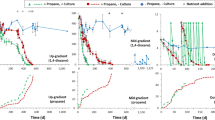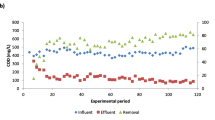Abstract
Long term natural attenuation of 1,4-dioxane (dioxane) and its enhanced biodegradation after bioaugmentation with Pseudonocardia dioxanivorans CB1190 were assessed using flow-through aquifer columns. Natural attenuation of dioxane was not observed even after 2 years of acclimation. However, dioxane removal was observed in the bioaugmented columns (34% when the influent was 200 µg/L and 92% for 5 mg/L). The thmA gene that encodes the tetrahydrofuran monooxygenase that initiates dioxane degradation by CB1190 was only detected at the inoculation port and persisted for months after inoculation, implying the resiliency of bioaugmentation and its potential to offer long-term enhanced biodegradation capabilities. However, due to extensive clumping and limited mobility of CB1190, the augmented catabolic potential may be restricted to the immediate vicinity of the inoculation port. Accordingly, bioaugmentation with CB1190 seems more appropriate for the establishment of biobarriers. Bioaugmentation efficiency was associated with the availability of oxygen. Aeration of the column influent to increase dissolved oxygen significantly improved dioxane removal (p < 0.05), suggesting that (for sites with oxygen-limiting conditions) bioaugmentation can benefit from engineered approaches for delivering additional oxygen.





Similar content being viewed by others

References
Adamson DT, Anderson RH, Mahendra S, Newell CJ (2015) Evidence of 1,4-dioxane attenuation at groundwater sites contaminated with chlorinated solvents and 1,4-dioxane. Environ Sci Technol 49(11):6510–6518
Adamson DT, Mahendra S, Walker KL Jr, Rauch SR, Sengupta S, Newell CJ (2014) A multisite survey to identify the scale of the 1,4-dioxane problem at contaminated groundwater sites. Environ Sci Technol Lett 1(5):254–258
Aitchison EW, Kelley SL, Alvarez PJJ, Schnoor JL (2000) Phytoremediation of 1,4-dioxane by hybrid poplar trees. Water Environ Res 72(3):313–321
Barajas Rodriguez FJ (2016) Evaluation of 1,4-dioxane biodegradation under aerobic and anaerobic conditions. All Dissertations. 1856. https://tigerprints.clemson.edu/all_dissertations/1856
Barajas-Rodriguez FJ, Freedman DL (2018) Aerobic biodegradation kinetics for 1,4-dioxane under metabolic and cometabolic conditions. J Hazard Mater 15(350):180–188
Blotevogel J, Pijls C, Scheffer B, de Waele JP, Lee A, van Poecke R, van Belzen N, Staal W (2019) Pilot-scale electrochemical treatment of a 1,4-dioxane source zone. Groundw Monit Remediat 39(1):36–42
Costura RK, Alvarez PJJ (2000) Expression and longevity of toluene dioxygenase in Pseudomonas putida F1 induced at different dissolved oxygen concentrations. Water Res 34(11):3014–3018
Da Silva MLB, Alvarez PJJ (2002) Effects of ethanol versus MTBE on benzene, toluene, ethylbenzene, and xylene natural attenuation in aquifer columns. J Environ Eng 128(9):862–867
Deng D, Li F, Li M (2017) A novel propane monooxygenase initiating degradation of 1,4-dioxane by Mycobacterium dioxanotrophicus PH-06. Environ Sci Technol Lett 5(2):86–91
Deng D, Li F, Wu C, Li M (2018) Synchronic biotransformation of 1,4-dioxane and 1,1-dichloroethylene by a Gram-negative Propanotroph azoarcus sp. DD4. Environ Sci Technol Letters 5(8):526–532
Domenico PA, Schwartz FW (1998) Physical and chemical hydrogeology. Wiley, New York
Gannon JT, Mingelgrin U, Alexander M, Wagenet RJ (1991) Bacterial transport through homogeneous soil. Soil Biol Biochem 23(12):1155–1160
Grostern A, Alvarez-Cohen L (2013) RubisCO-based CO2 fixation and C1 metabolism in the actinobacterium Pseudonocardia dioxanivorans CB1190. Environ Microbiol 15(11):3040–3053
Grostern A, Sales CM, Zhuang W-Q, Erbilgin O, Alvarez-Cohen L (2012) Glyoxylate metabolism is a key feature of the metabolic degradation of 1,4-dioxane by Pseudonocardia dioxanivorans strain CB1190. Appl Environ Microbiol 78(9):3298–3308
He Y, Mathieu J, da Silva MLB, Li M, Alvarez PJJ (2018) 1,4-Dioxane-degrading consortia can be enriched from uncontaminated soils: prevalence of Mycobacterium and soluble di-iron monooxygenase genes. Microb Biotechnol 11(1):189–198
He Y, Mathieu J, Yang Y, Yu P, da Silva MLB, Alvarez PJJ (2017) 1,4-Dioxane biodegradation by Mycobacterium dioxanotrophicus PH-06 is associated with a group-6 soluble di-iron monooxygenase. Environ Sci Technol Lett 4(11):494–499
Hockin SL, Gadd GM (2003) Linked redox precipitation of sulfur and selenium under anaerobic conditions by sulfate-reducing bacterial biofilms. Appl Environ Microbiol 69(12):7063–7072
Huang H, Shen D, Li N, Shan D, Shentu J, Zhou Y (2014) Biodegradation of 1,4-dioxane by a novel strain and its biodegradation pathway. Water Air Soil Pollut 225(9):2135
Hurst CJ, Crawford RL, Garland JL, Lipson DA (2007) Manual of environmental microbiology. American Society for Microbiology Press, Washington, DC
Ikehata K, Wang-Staley L, Qu X, Li Y (2016) Treatment of groundwater contaminated with 1,4-dioxane, tetrahydrofuran, and chlorinated volatile organic compounds using advanced oxidation processes. Ozone: Sci Eng 38(6):413–424
Inoue D, Tsunoda T, Yamamoto N, Ike M, Sei K (2018) 1,4-Dioxane degradation characteristics of Rhodococcus aetherivorans JCM 14343. Biodegradation 29(3):301–310
Khan NA, Johnson MD, Kubicki JD, Holguin FO, Dungan B, Carroll KC (2019) Cyclodextrin-enhanced 1,4-dioxane treatment kinetics with TCE and 1,1,1-TCA using aqueous ozone. Chemosphere 219:335–344
Kim Y-M, Jeon J-R, Murugesan K, Kim E-J, Chang Y-S (2009) Biodegradation of 1,4-dioxane and transformation of related cyclic compounds by a newly isolated Mycobacterium sp. PH-06. Biodegradation 20(4):511
Kishimoto N, Yasuda Y, Mizutani H, Ono Y (2007) Applicability of ozonation combined with electrolysis to 1,4-dioxane removal from wastewater containing radical scavengers. Ozone: Sci Eng 29(1):13–22
Li M, Fiorenza S, Chatham JR, Mahendra S, Alvarez PJJ (2010) 1, 4-Dioxane biodegradation at low temperatures in Arctic groundwater samples. Water Res 44(9):2894–2900
Li M, Conlon P, Fiorenza S, Vitale RJ, Alvarez PJJ (2011) Rapid analysis of 1,4-dioxane in groundwater by frozen micro-extraction with gas chromatography/mass spectrometry. Groundw Monit Remediat 31(4):70–76
Li M, Mathieu J, Liu Y, Van Orden ET, Yang Y, Fiorenza S, Alvarez PJJ (2013) The abundance of tetrahydrofuran/dioxane monooxygenase genes (thmA/dxmA) and 1,4-dioxane degradation activity are significantly correlated at various impacted aquifers. Environ Sci Technol Lett 1(1):122–127
Li M, Liu Y, He Y, Mathieu J, Hatton J, DiGuiseppi W, Alvarez PJJ (2017) Hindrance of 1,4-dioxane biodegradation in microcosms biostimulated with inducing or non-inducing auxiliary substrates. Water Res 112:217–225
Li F, Deng D, Li M (2020) Distinct catalytic behaviors between two 1,4-dioxane-degrading monooxygenases: Kinetics, inhibition, and substrate range. Environ Sci Technol 54(3):1898–1908
Lippincott D, Streger SH, Schaefer CE, Hinkle J, Stormo J, Steffan RJ (2015) Bioaugmentation and propane biosparging for in situ biodegradation of 1,4-dioxane. Groundw Monit Remediat 35(2):81–92
MacFarlane KD, Cacciatore DA, Leigh DP, Yurovsky MG, Atta A (2011) Field-scale evaluation of a biobarrier for the treatment of a trichloroethene plume. Remediat J 22(1):29–41
Mahendra S, Alvarez-Cohen L (2005) Pseudonocardia dioxanivorans sp. nov., a novel actinomycete that grows on 1,4-dioxane. Int J Syst Evolut Microbiol 55(2):593–598
Mahendra S, Alvarez-Cohen L (2006) Kinetics of 1,4-dioxane biodegradation by monooxygenase-expressing bacteria. Environ Sci Technol 40(17):5435–5442
Masuda H, McClay K, Steffan RJ, Zylstra GJ (2012) Biodegradation of tetrahydrofuran and 1,4-dioxane by soluble diiron monooxygenase in Pseudonocardia sp. strain ENV478. J Mol Microbiol Biotechnol 22(5):312–316
Mohr TKG, Stickney JA, DiGuiseppi WH (2016) Environmental investigation and remediation: 1,4-dioxane and other solvent stabilizers. CRC Press, Boca Raton
Parales RE, Adamus JE, White N, May HD (1994) Degradation of 1,4-dioxane by an actinomycete in pure culture. Appl Environ Microbiol 60(12):4527–4530
Polasko AL, Zulli A, Gedalanga PB, Pornwongthong P, Mahendra S (2018) A mixed microbial community for the biodegradation of chlorinated ethenes and 1,4-dioxane. Environ Sci Technol Lett 6(1):49–54
Salanitro JP, Johnson PC, Spinnler GE, Maner PM, Wisniewski HL, Bruce C (2000) Field-scale demonstration of enhanced MTBE bioremediation through aquifer bioaugmentation and oxygenation. Environ Sci Technol 34(19):4152–4162
Sales CM, Mahendra S, Grostern A, Parales RE, Goodwin LA, Woyke T, Nolan M, Lapidus A, Chertkov O, Ovchinnikova G (2011) Genome sequence of the 1,4-dioxane-degrading Pseudonocardia dioxanivorans Strain CB1190. J Bacteriol 193(17):4549–4550
Son HS, Choi SB, Khan E, Zoh KD (2006) Removal of 1,4-dioxane from water using sonication: effect of adding oxidants on the degradation kinetics. Water Res 40(4):692–698
Sei K, Miyagaki K, Kakinoki T, Fukugasako K, Inoue D, Ike M (2013) Isolation and characterization of bacterial strains that have high ability to degrade 1,4-dioxane as a sole carbon and energy source. Biodegradation 24(5):665–674
Streger SH, Vainberg S, Dong H, Hatzinger PB (2002) Enhancing transport of hydrogenophaga flava ENV735 for bioaugmentation of aquifers contaminated with methyl tert-butyl ether. Appl Environ Microbiol 68(11):5571–5579
Suzuki MT, Taylor LT, DeLong EF (2000) Quantitative analysis of small-subunit rRNA genes in mixed microbial populations via 5′-nuclease assays. Appl Environ Microbiol 66(11):4605–4614
U.S.EPA (2014) Technical fact sheet – 1,4-dioxane, EPA 505-F-14-011.
von Gunten U, Zobrist J (1993) Biogeochemical changes in groundwater-infiltration systems: column studies. Geochim Cosmochim Acta 57(16):3895–3906
Yamazaki S, Yamabe N, Nagano S, Fukuda A (2007) Adsorption and photocatalytic degradation of 1,4-dioxane on TiO2. J Photochem Photobiol 185(2):150–155
Wang Z, Feyen J (1998) Air entrapment effects on infiltration rate and flow instability. Water Resour Res 34(2):213–222
Zenker MJ, Borden RC, Barlaz MA (2003) Occurrence and treatment of 1,4-dioxane in aqueous environments. Environ Eng Sci 20(5):423–432
Zhang S, Gedalanga PB, Mahendra S (2016) Biodegradation kinetics of 1,4-dioxane in chlorinated solvent mixtures. Environ Sci Technol 50(17):9599–9607
Zhao L, Lu X, Polasko A, Johnson NW, Miao Y, Yang Z, Mahendra S, Gu B (2018) Co-contaminant effects on 1,4-dioxane biodegradation in packed soil column flow-through systems. Environ Pollut 243:573–581
Acknowledgements
This work was supported by the Strategic Environmental Research and Development Program (SERDP)—Environmental Security Technology Certification Program (ESTCP) [Grant Number ER-2301].
Author information
Authors and Affiliations
Corresponding author
Additional information
Publisher's Note
Springer Nature remains neutral with regard to jurisdictional claims in published maps and institutional affiliations.
Rights and permissions
About this article
Cite this article
da Silva, M.L.B., He, Y., Mathieu, J. et al. Enhanced long-term attenuation of 1,4-dioxane in bioaugmented flow-through aquifer columns. Biodegradation 31, 201–211 (2020). https://doi.org/10.1007/s10532-020-09903-0
Received:
Accepted:
Published:
Issue Date:
DOI: https://doi.org/10.1007/s10532-020-09903-0



